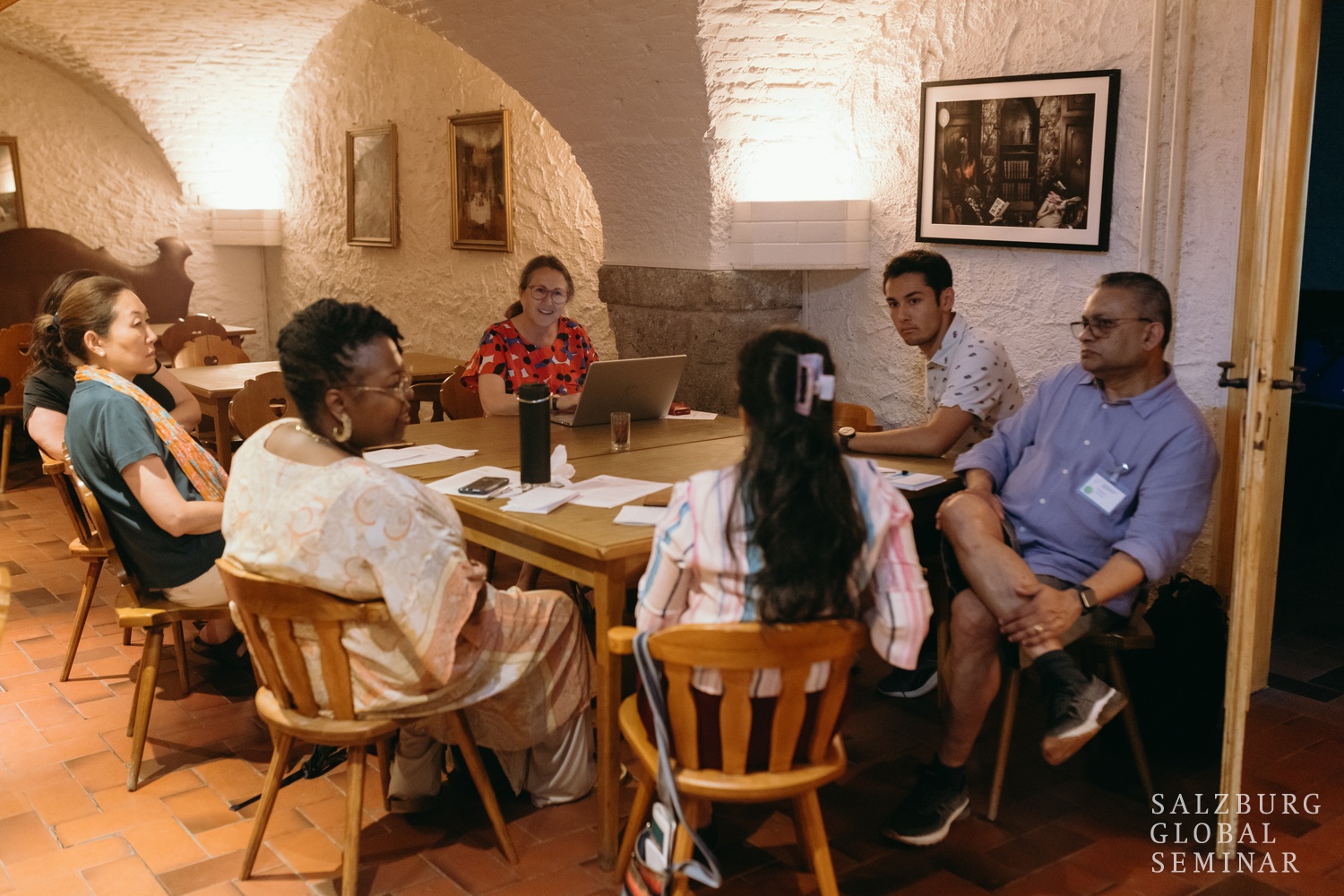There is no such thing as a single-issue struggle because we do not live single-issue lives, as the poet Audre Lorde once said.
Likewise, the challenges of providing for basic human needs such as food, water and housing are deeply interconnected. The search for solutions is made even more complex by the sometimes conflicting demands of between and even among capital providers, communities – and other stakeholders.
“I found myself wondering if financial instruments are the best way to address the root cause of some of the problems,” Murray Gray of the Netherlands-based impact consultancy Metabolic wrote in his reflections on the recent “Connecting Capital to Communities” gathering at the Salzburg Global Seminar in Austria. “Maybe financial intervention is not the thing. Instead, maybe the intervention is something else entirely.”
The gathering, sponsored by the Robert Wood Johnson Foundation, brought together nearly 50 changemakers across issue areas and geographies to “harness financial markets for essential social infrastructure.”
ImpactAlpha, the media partner for the convening, is producing a series of podcast conversations with delegates (the first two featured Vienna’s Michaela Kauer on that city’s affordable housing model and FarMart’s Samridhi Singh on connecting Indian farmers to global markets).
Absorptive capacity
In the U.S., thanks to recent legislation, there is in many cases a healthy supply of capital to fund physical and even social infrastructure. But a shortage of “absorptive capacity” on the part of communities means that capital can sometimes resemble a plane with nowhere to land.
“We see the capital is not getting to the communities where it needs to go,” said Robert Wood Johnson’s Kimberlee Cornett. She cited the “capital absorption” framework developed by Robin Hacke of the Center for Community Investment in Cambridge, Mass. The reasons for such lack of capacity include policy failures, readiness gaps, risk perceptions and access to and the price of capital.
And even the refrain of “too much money, not enough projects” rang hollow to many delegates, particularly those from the global South.
“Where we come from, there isn’t capital. It isn’t there. It doesn’t want to come there,” said Empowa’s Glen Jordan, who is working on affordable housing solutions. Empowa is developing a rent-to-own model to tackle the challenges of affordable housing in emerging markets, starting in Mozambique, a country of 32 million people with a total of only 600 outstanding mortgage loans. Empowa’s blockchain-based approach lets renters build equity over time and assures developers with the cash flows they need to finance their projects.
“When there’s no formality, there’s no identification. Income is informal. The mortgage product just doesn’t work,” Jordan said. “So we have to turn it around and create products that meet the needs of the informal market.”
True value of food
Barring a back-ended surge before the 2030 deadline, the global Sustainable Development Goals are looking like a utopian pipe-dream. Only 12% of the 169 specific goals are on track, 50% are off track, and for 30-40% of the goals, the world is actually getting worse off. And it’s not just COVID and the war in Ukraine – even in 2019, the world was not on track to meet SDG No. 1: End poverty in all its forms everywhere.
Bottom-up solutions will be key to any progress. Most of the world’s food is grown by smallholder farmers, for example, who also represent the bulk of the world’s poor.
“Think about that paradox: the hungry farmer,” said One Acre Farm’s Chanda Banda. “It doesn’t make sense.”
One Acre supplies inputs, advice and credit, and has a global repayment average of 98%, Banda said. “They pay back loans because their livelihood depends on getting the inputs from us,” he said. Banda borrowed a phrase from another delegate that became a mantra of the seminar: “Capital moves in the direction of trust.”
One of the seminar’s working groups produced a draft framework for a bond based on the “true value of food,” modeled on other green and sustainability bonds, to lower capital costs for producers transitioning to healthy, sustainable food production and distribution.
The global food system produces negative externalities that are not accounted for in the cost structure, said Suzanne van Tilburg of Rabobank, the Dutch lender that has focused heavily on food and agriculture. That includes an estimated $12 trillion annually in hidden health costs and $7 trillion in environmental damage, more than double the value of food consumption itself.
“How can it be that we have a food system where unhealthy, unsustainable food is the norm and is affordable,” van Tilburg asked, “while healthy, sustainable food is expensive and unaffordable?”
Community-led
The word “community” has almost talismanic power in social-change discussions. Yet even the most well-intentioned advocates have to accept that communities may have different, or conflicting priorities.
In New York City for example, Local Law 97 enacted in 2019, pitted some affordable housing proponents against climate advocates when affordable housing projects were exempted from the law’s greenhouse gas reduction targets. In another city, a series of community meetings determined that locals prioritized soccer fields over affordable housing.
“That challenged everything that I have been trained in,” Cornett recalled. “How do we get comfortable when communities make different choices?”
How do communities see themselves? “Beneficiaries,” or customers, for example, may see themselves differently than do the social enterprises or impact investors seeking to serve them. Many farmers and shopkeepers do not identify themselves by their roles or their crops, said FarMart’s Singh, but by their families, their children, their villages and their ethnicities.
And communities exist in cities, states and nations. “We are reliant on government to help us,” said Habitat for Humanity International’s Patrick Canagasingham. “When institutional structures are weak, it’s hard to make sure outcomes are consistent with what communities are seeking.”
Power dynamics
Salzburg Global Seminar, a 75-year-old nonprofit that operates from a storied “schloss,” or palace, on a picturesque lake (made famous as a setting for the movie, “The Sound of Music”), emphasizes hands-on solution-building. Delegates worked in small groups to develop concrete proposals to take forward after the gathering.
That process was not without its own power dynamics. “Despite the inspiring, thoughtful, talented, motivated group we had, I observed the very issues we are looking to address,” said Metabolic’s Gray. “I also observed that the larger the group, the more Europeans and Americans spoke. Those from Africa and Asia more needed to be ‘invited in.’”
He noted the group slanted towards the technical and mechanistic, rather than holistic solutions, suggesting the need for Inner Development Goals to complement the global Sustainable Development Goals.
Resilience Capital’s Triple B framework attempts to tackle such power dynamics, identifying bottlenecks and blind spots as well as blended capital solutions
“How much do we value nonfinancial capital?” asked Resilience Capital’s Cathy-Mae Karelse. “How much do we attach value to the fact that our communities have knowledge and wisdom?”
Community knowledge and wisdom can provide ways to measure impact as well.
“Not everything can be told through numbers,” Gray said. “We are feeling, storytelling beings. Culture can be the soil for change. This soil is made up of narratives and stories. We can cultivate that soil.”











